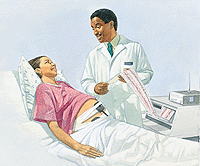Checking on Your Baby
Checking on Your Baby
It's normal to worry about your baby's health. One way that you can know your baby's doing well is to record the baby's movements once a day. Your healthcare provider may also do tests to check on your baby's size and development. These tests help plan for your labor and delivery.
Kick Counts
Starting around week 26 of your pregnancy, your healthcare provider may have you count your baby's movements once a day. This is called kick counts. Choose a time when the baby is active, such as after a meal. Here is one way to do it:
Sit comfortably or lie on your side.
The first time the baby moves, write down the time.
Count each movement until the baby has moved 10 times. This usually takes 10 to 20 minutes. If the baby hasn't moved at least 4 times in 1 hour, get up and move around, or eat something to wake the baby up.
Write down the time you feel the baby's 10th movement. Take your kick count records to all your appointments.
Other Tests
Your healthcare provider may order tests to make sure your baby is doing well. These may include:
Nonstress test (NST). A special belt is put around your waist to count your baby's heart rate. The heart rate should go up when the baby moves.
Ultrasound. Harmless sound waves make a picture (sonogram) of your baby on a screen. The picture shows your baby's size and position. This test helps determine the well-being of the baby.
Amniocentesis. A sample of the fluid around your baby is removed and tested to see whether the baby's lungs can work on their own. This test may be done if the baby needs to be delivered early.
When to Call Your Healthcare Provider
Call your healthcare provider right away if you notice any of the following:
Your baby moves fewer than 10 times in 2 hours while you're doing kick counts.
Your baby moves much less often than on the days before.
You have not felt your baby move all day.
Updated:
March 21, 2017
Reviewed By:
Dolan, Mary, MD,Nancy BowersNancy Bowers RN MPH

